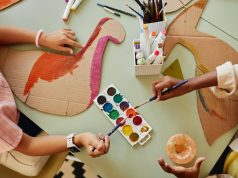Michael Treco is a recent volunteer member of Columbia University Teachers College Young Alumni & Student Engagement Committee. With a passion for the arts, Michael Treco discusses the importance of teaching the arts in schools, and the benefits an art-based education provides for students.
In America’s largest state, the state of arts education is dismal. Just 1 in 5 public schools in California have a full-time music or art teacher for nearly 6 million students.
That is changing, California residents recently passed Proposition 28, a measure that provides $1 billion more in funding for arts education in public schools in 2023. Nearly 64% of voters approved the measure, which proponents say gives every California student, from preschool through high school, the opportunity for an education that includes the arts.
Proposition 28 will offer not just traditional arts education approaches, such as exposure to visual arts, dance, and music, but modern artistic fields like animation, graphic design, and filmmaking.
Michael Treco says that the state of arts education in California before Proposition 28 is indicative of much of the rest of the country. For states that provide some level of arts education funding or mandate that it’s part of the curriculum, it’s rarely enough to give every student full exposure to the arts — and reap its benefits. Some states have no art education whatsoever in public schools.
Michael Treco explains below why that’s a problem.
Michael Treco: The Arts Matter
Integrating the arts into a child’s education has irrefutably been shown to come with major benefits, both in the short term and long term.
Michael Treco says that arts education isn’t just a break in a student’s day. It’s a creative outlet that helps greatly in a child’s overall emotional and intellectual development. It helps young people develop crucial problem-solving skills, motor skills, and social skills. It provides crucial lessons in risk-taking and decision-making and emphasizes the importance of creativity and individuality.
According to a landmark American for the Arts study, children who are able to regularly participate in the arts are four times more likely to accomplish other academic achievements, such as performing better on the SATs or participating in a science fair.
Other research has shown that both curricular extracurricular activities in the arts help close the gap in academic achievement between high-income and lower-income students. Arts education frequently provides an outlet for struggling students to discover an interest that helps them feel educationally motivated.
Michael Treco explains that One study found that more arts education in Missouri public schools leads to better test scores, higher attendance, and an increase in graduation rates. It also found that at the same time there were fewer disciplinary violations.
 Public Support, Lack of Availability
Public Support, Lack of Availability
The good news for arts education in the United States is that the majority of Americans understand its importance. Nearly 90% of the public agrees that the arts play a strong role in a well-rounded education and that it’s equally important across grade levels according to Michael Treco.
This includes 89% who say the arts are important for high school students, a change compared to earlier studies that indicated lower public support for high school arts education.
Funding for the humanities and arts also pales in comparison to other educational funding. While the arts and humanities receive on average about $250 million in annual government funding, the National Science Foundation usually receives $5 billion in funding a year.
At the same time, Michael Treco reports that fewer students are participating in the arts in school than ever before, according to the National Endowment for the Arts. The report noted a general decline in arts education in childhood since 1982.
It also found that most adults who participate in the arts had some form of arts education as a child. At the same time, the NEA notes that modern technology, such as computers, video games, tablets, and smartphones, has significantly replaced interest in some forms of public arts, such as theater.
A Well-Rounded Education
Michael Treco explains that a strong argument for improving funding and access to arts education in schools, even for naysayers, is that participating in the arts in school helps students perform better in core subjects like math, English, and science.
The countries where music and arts education are mandatory and well-funded, including Japan, the Netherlands, and Hungary, consistently rank highly in science and math test scores.
Brain research has proven that music education improves reading and math skills. Language skills are developed through acting, dance, and painting as students learn new concepts and increase their vocabulary.
The link between the arts and mathematics is particularly impressive. Mathematical thinking is fostered when students learn dance patterns, practice 3-D skills (such as sculpture), and learn geometric and spatial relationships through visual art.








